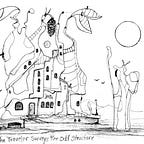Micro-Prairie Maintenance
Bloodroot in bloom means the micro-prairie is coming to life. Brown leaves crumble to slow release fertilizer and native grasses shoot up. Within days, brown stubble is replaced by green foliage. Purple native violets are the next to bloom followed by showy non-native bleeding hearts. The number of non-native plants in the micro-prairie has steadily diminished as I have dug them out or just neglected them until they disappear. The bleeding hearts hang around because they fit well in the shade garden and are not aggressive. If they die out I won’t replant them but in the meantime I will enjoy their pink hearts for a week or two each spring.
In the front yard near the bloodroot, the pollinator garden I planted last year is showing signs of life. The city and county teamed up to offer a small packet of native plant seeds to people who were getting rid of grass. I planted the seeds in late June in a bare spot along the front sidewalk. Black eyed Susans, gaillardia and false sunflowers came up and bloomed until a hard freeze last fall. Many of the plants are coming up now so I hope for an even better stand of color this summer next to my front yard patio. It is nice to sit on the patio bench with a cup of coffee and enjoy early morning sunshine. Below is a picture of the patio now and below that is a picture of how it looked last year. In spring it looks a little scraggly but by summer it will be reborn into a vibrant spot of color. I just have to wait. Patience is required.
We will finish our tour of the micro-prairie at the back yard pond and then I will describe the annual maintenance I perform on the micro-prairie. In the past the “pond” consisted of two hog pans placed together in a depression. But this year I went all in and dug a larger depression that I lined with a sheet of polyethylene that had been in my garage for years. When the pond started to fill up, I slid the pan from last year’s pond into the middle of it. The pan had remains of cattails from previous years. After recent rain, the pan is fully submerged and the cattails have come up. I love it when I cobble things together and they work! Now if a frog shows up it will be perfect.
The micro-prairie doesn’t require much maintenance which makes it a terrific alternative to toxic turf grass. The primary action I take every spring is to charge up the hedge trimmer and use that to chop off stalks near ground level. I leave the stalks where they fall unless the pile is too thick. In a few weeks the stalks will no longer be visible as they decompose and release valuable nutrients. Then, after the stalks are down, I roam the micro-prairie looking for weeds. This is a year around task but it is best done in spring before the weeds get too strong. Dandelions are easy to pop out of the ground so that is where I start. Then I look for other invasive weeds although it is sometimes hard to identify weeds when they are small. But, if a plant shoots out of the ground ahead of everything else it may well be a weed — like the dames rocket which popped up in several places. It looks like garden phlox is kind of pretty but don’t be fooled — it will take over and force out desirable plants. I also dug out remnants of non-native ground covers that I recklessly planted many years ago.
In other news, I will be giving a talk at an art market at Bronze Age foundry on May 25th. This will be the second anniversary of the native garden we planted at the foundry. Lisa from Bronze Age has a Facebook event for those of you who are on Facebook.
If you want a quick refresher on making a native planting, check out the Quick Reference article on the main page of this blog. It is a recap of how and why I planted the micro-prairie. If you are wanting to add natives to your yard, now is the time to get busy. You can plant live plants in May as well as bare root plants. There are also seeds that don’t need stratification — like the pollinator garden kit I planted last June — that you can plant now and enjoy this summer. The main thing is just do it! Rip out some turf grass and then figure out what to do. There are a lot of things you can do that will be better than toxic turf grass. Give it your best shot and if it doesn’t work, try something else. Happy planting!
